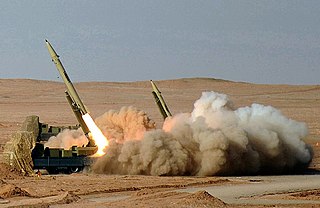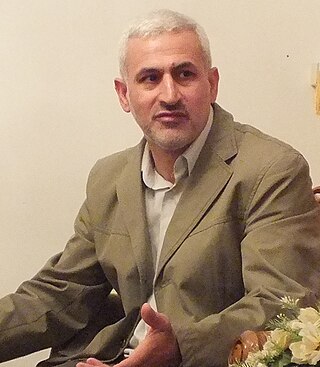
The Fateh-110, also known as NP-110 is an Iranian solid-fueled surface-to-surface ballistic missile produced by Iran's Aerospace Industries Organization since 2002. It is single-stage, road-mobile and can carry a high-explosive warhead of up to 500 kg. Four different versions, the Fateh-110A, 110B, 110D-1 and Fateh-E Mobin were developed with varying accuracy. The latest version, first shown to the public in August 2018 reportedly has a range of 300 km is reportedly more accurate than previous versions.

The History of the Israel Air Force begins in May 1948, shortly after the formation of the State of Israel. Following Israel's declaration of independence on May 14, its pre-state national institutions transformed into the agencies of a state, and on May 26, 1948, the Israeli Air Force was formed. Beginning with a small collection of light aircraft, the force soon transformed into a comprehensive fighting force. It has since participated in several wars and numerous engagements, becoming what has been described as "The mightiest air force in the Middle East".

Foreign involvement in the Syrian civil war refers to political, military and operational support to parties involved in the ongoing conflict in Syria that began in March 2011, as well as active foreign involvement. Most parties involved in the war in Syria receive various types of support from foreign countries and entities based outside Syria. The ongoing conflict in Syria is widely described as a series of overlapping proxy wars between the regional and world powers, primarily between the United States and Russia as well as between Iran and Saudi Arabia.
The Scientific Studies and Research Center (SSRC), better known by its French name Centre D'Etudes et de Recherches Scientifiques (CERS), is a Syrian government agency that has the goal of advancing and coordinating scientific and military research activities in the country. It works on research and development for the economic and social development of Syria, especially the computerization of government agencies. It is considered to have better technical capacity and equipment than the Syrian universities. Jane's Information Group Intelligence Services and other analysts believe it is responsible for research and development of nuclear, biological, chemical and missile technology and weapons, including ballistic missiles, as well as advanced conventional arms.
Jamraya or Jemraya is a village in the Qudsaya District of Rif Dimashq in southern Syria. It lies 3 miles (5 km) to the northwest of the Syrian capital of Damascus city, beyond Mount Qasioun, and is now an outlying suburb of greater Damascus. It is between al-Hamah and Qudsaya town to the south, and Ashrafiyat al-Wadi to the north. It is about 10 miles (15 km) from the Lebanese border. According to the Syria Central Bureau of Statistics, the village had a population of 1,156 in the 2004 census.
The following is a timeline of the Syrian civil war from May to December 2013. Information about aggregated casualty counts is found at Casualties of the Syrian Civil War.

The Iran–Israel proxy conflict, also known as the Iran–Israel proxy war or Iran–Israel Cold War, is an ongoing proxy conflict between Iran and Israel. In the Israeli–Lebanese conflict, Iran has supported Lebanese Shia militias, most notably Hezbollah. In the Israeli-Palestinian conflict, Iran has backed Palestinian groups such as Hamas. Israel has supported Iranian rebels, such as the People's Mujahedin of Iran, conducted airstrikes against Iranian allies in Syria and assassinated Iranian nuclear scientists. In 2018 Israeli forces directly attacked Iranian forces in Syria.

The May 2013 Rif Dimashq airstrikes were a series of aerial attacks made on targets in Syria on 3 and 5 May 2013. The 3 May attack was on targets at Damascus International Airport. The 5 May attacks were on targets at Jamraya, and the Al-Dimas and Maysalun areas in Rif Dimashq. Although officially Israel neither confirmed nor denied its involvement, former Mossad director Danny Yatom and former government member Tzachi Hanegbi inferred Israel's involvement in the attack. Official Syrian sources denied any attack on its soil on 3 May, but did accuse Israel for the attacks on 5 May.

The Islamic Republic of Iran and the Syrian Arab Republic are close strategic allies, and Iran has provided significant support for the Syrian government in the Syrian civil war, including logistical, technical and financial support, as well as training and some combat troops. Iran sees the survival of the Syrian government as being crucial to its regional interests. When the uprising developed into the Syrian Civil War, there were increasing reports of Iranian military support, and of Iranian training of the National Defence Forces both in Syria and Iran. From late 2011 and early 2012, Iran's IRGC began sending tens of thousands of volunteers in co-ordination with the Syrian government to prevent the collapse of the Syrian Arab Army; thereby polarising the conflict along sectarian lines.

Following the outbreak of the protests of Syrian revolution during the Arab Spring in 2011 and the escalation of the ensuing conflict into a full-scale civil war by mid-2012, the Syrian Civil War became a theatre of proxy warfare between various regional powers such as Turkey and Iran. Spillover of the Syrian civil war into the wider region began when the Iraqi insurgent group known as the Islamic State of Iraq (ISI) started intervening in the conflict from 2012.

Several incidents have taken place on the Israeli–Syrian ceasefire line during the Syrian Civil War, straining the relations between the countries. The incidents are considered a spillover of the Quneitra Governorate clashes since 2012 and later incidents between Syrian Army and the rebels, ongoing on the Syrian-controlled side of the Golan and the Golan Neutral Zone and the Hezbollah involvement in the Syrian Civil War. Through the incidents, which began in late 2012, as of mid-2014, one Israeli civilian was killed and at least 4 soldiers wounded; on the Syrian-controlled side, it is estimated that at least ten soldiers were killed, as well as two unidentified militants, who were identified near Ein Zivan on Golan Heights.

The December 2014 Rif Dimashq airstrikes were a series of aerial attacks made on targets in Syria on 7 December 2014. The targets were a military area in Al-Dimas and the Damascus International Airport area.
Events in the year 2015 in Israel.
The January 2015 Mazraat Amal incident was an airstrike against a two-car convoy that killed six Hezbollah fighters, including two prominent commanders, and a general of the Iranian Revolutionary Guards (IRGC), Mohammad Ali Allahdadi, at al-Amal Farms in the Quneitra District of Syria, in the Eastern Golan Heights, on 18 January 2015, during the Syrian Civil War. The attack was largely attributed to Israel, which did not officially confirm that it carried it out. Hezbollah and IRGC held Israel responsible and threatened to retaliate. On 19 January 2015, Al-Nusra Front member Abu Azzam al-Idlibi claimed that Jihad Mughniyeh and the other Hezbollah fighters were killed in an Al-Nusra Front ambush at Jaroud in the Qalamoun Mountains in the Al-Qutayfah District northeast of Damascus, claiming that it "will be the end of the Persian project, God willing."
Israel's official position on the Syrian Civil War has been strict neutrality. However, Israel has become involved politically and militarily to prevent the growing influence and entrenchment of Iranian forces and its proxies throughout Syria. Israel's military activity, officially called Operation Chess, has primarily been limited to missile and air strikes targeting Iranian facilities in Syria as well as those of its proxies, especially Hezbollah. These attacks were not officially acknowledged before 2017. Israel has also carried out air strikes in Syria to disrupt weapons shipments to Hezbollah. By August 2022, the UK investigative non-profit Airwars estimated that 17-45 civilians were killed and another 42-101 civilians were wounded by Israeli airstrikes in Syria since 2013. Syrian reports place these figures much lower than other foreign actors in the conflict. Israel has also provided humanitarian aid to victims of the civil war from 2013 to September 2018, an effort that was ramped up after June 2016 with the launch of Operation Good Neighbour.

Hezbollah involvement in the Syrian Civil War has been substantial since the beginning of armed insurgency phase of the Syrian Civil War in 2011, and evolved into active support for Ba'athist government forces and troop deployment from 2012 onwards. By 2014, Hezbollah was deployed across Syria. Hezbollah has also been very active in preventing Al-Nusra Front and Islamic State penetration into Lebanon, being one of the most active forces in the Syrian Civil War spillover in Lebanon.

Hassan Shateri, also known as Hesam Khoshnevis, was an Iranian military officer and Major General of Iran's elite IRGC Quds Force. He was a veteran of the Iran–Iraq war and head of the Iranian Committee for the Reconstruction of Lebanon after the 2006 Lebanon War, according to Iranian media. He was assassinated in February 2013.
The following is a timeline of the Syrian Civil War from September to December 2017. Information about aggregated casualty counts is found at Casualties of the Syrian Civil War.
The Iran–Israel conflict during the Syrian civil war refers to the Iranian–Israeli standoff in and around Syria during the Syrian conflict. With increasing Iranian involvement in Syria from 2011 onwards, the conflict shifted from a proxy war into a direct confrontation by early 2018.











